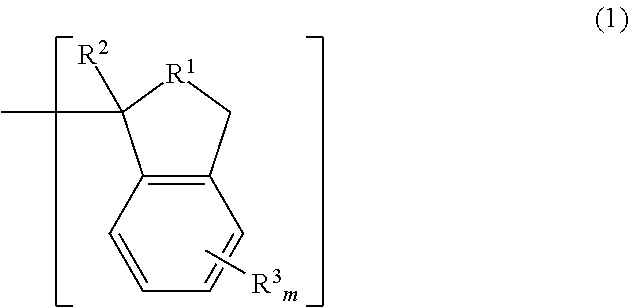Positive resist composition and patterning process
a technology of resist and composition, applied in the field of positive resist composition, can solve the problems of eliminating the protective group, and achieve the effects of high contrast, good pattern profile, and high resolution
- Summary
- Abstract
- Description
- Claims
- Application Information
AI Technical Summary
Benefits of technology
Problems solved by technology
Method used
Image
Examples
synthesis example 1
Monomer Synthesis Example 1
Synthesis of Monomer 1
[0143]
[0144]With stirring and ice cooling, 111 g of triethylamine was added to a mixture of 120 g of methacrylic acid chloride, 180 g of 5-fluoro-1-methylindan-1-ol, and 1500 g of toluene. The mixture was stirred at room temperature for 16 hours. By standard aqueous work-up and solvent distillation, a crude product was obtained. It was purified by column chromatography, yielding the target compound, designated Monomer 1.
[0145]By the same procedure, Monomers 2 to 8 were synthesized. In the synthesis of Monomers 5 to 8, the reactant 5-fluoro-1-methylindan-1-ol was replaced by 5-fluoro-1-ethylindan-1-ol for Monomer 5, 5-fluoro-1-cyclopropylindan-1-ol for Monomer 6, 7-fluoro-1,2,3,4-tetrahydro-1-methylnaphthalen-1-ol for Monomer 7, and 5-trifluoromethyl-1-methylindan-1-ol for Monomer 8.
[0146]In the synthesis of Monomers 2 to 4, the reaction was replaced by
reaction of 5-fluoro-1-methylindan-1-ol with 5-carboxylic acid-4-oxatricyclo[4.2.1.0...
polymer synthesis example 1
[0150]A 2-L flask was charged with 7.0 g of Monomer 1, 11.3 g of 4-acetoxystyrene, and 40 g of tetrahydrofuran as solvent. The reactor was cooled to −70° C. in a nitrogen atmosphere, whereupon vacuum evacuation and nitrogen blow were repeated three times. The reactor warmed up to room temperature whereupon 1.2 g of azobisisobutyronitrile (AIBN) was added as a polymerization initiator. The reactor was heated at 60° C. and reaction run for 15 hours. The reaction solution was precipitated from 1 L of isopropyl alcohol. The white solid was collected by filtration and dissolved again in a mixture of 100 mL of methanol and 200 mL of tetrahydrofuran, to which 10 g of triethylamine and 10 g of water were added. Deprotection reaction of acetyl group was conducted at 70° C. for 5 hours, followed by neutralization with acetic acid. The reaction solution was concentrated and dissolved in 100 mL of acetone. By similar precipitation, filtration, and drying at 60° C., a white polymer was obtained....
polymer synthesis example 2
[0158]A 2-L flask was charged with 5.4 g of Monomer 1, 13.7 g of 3-hydroxyphenyl methacrylate, and 40 g of tetrahydrofuran as solvent. The reactor was cooled to −70° C. in a nitrogen atmosphere, whereupon vacuum evacuation and nitrogen blow were repeated three times. The reactor warmed up to room temperature whereupon 1.2 g of AIBN was added as a polymerization initiator. The reactor was heated at 60° C. and reaction run for 15 hours. The reaction solution was precipitated from 1 L of isopropyl alcohol. The white solid was collected by filtration and vacuum dried at 60° C., obtaining a white polymer.
[0159]The polymer was analyzed by 13C-NMR, 1H-NMR, and GPC, with the analytical data shown below.
[0160]Copolymer Composition (Molar Ratio)
[0161]Monomer 1:3-hydroxyphenyl methacrylate=0.23:0.77
[0162]Mw=8,200
[0163]Mw / Mn=1.93
[0164]This is designated Polymer 2.
[0165]
PUM
| Property | Measurement | Unit |
|---|---|---|
| size | aaaaa | aaaaa |
| temperature | aaaaa | aaaaa |
| temperature | aaaaa | aaaaa |
Abstract
Description
Claims
Application Information
 Login to View More
Login to View More - R&D
- Intellectual Property
- Life Sciences
- Materials
- Tech Scout
- Unparalleled Data Quality
- Higher Quality Content
- 60% Fewer Hallucinations
Browse by: Latest US Patents, China's latest patents, Technical Efficacy Thesaurus, Application Domain, Technology Topic, Popular Technical Reports.
© 2025 PatSnap. All rights reserved.Legal|Privacy policy|Modern Slavery Act Transparency Statement|Sitemap|About US| Contact US: help@patsnap.com



